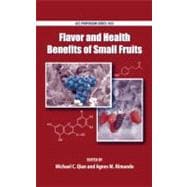
Note: Supplemental materials are not guaranteed with Rental or Used book purchases.
Purchase Benefits
What is included with this book?
| Preface | p. xi |
| Overview | |
| Flavor of Small Fruits | p. 3 |
| Evaluating Health Benefits of Various Fruits | p. 13 |
| Volatiles in Small Fruit | |
| Flavor Chemistry of Small Fruits: Blackberry, Raspberry, and Blueberry | p. 27 |
| Fractionation and Identification of Aroma-Active Constituents in Thornless Trailing 'Black Diamond' Blackberry | p. 45 |
| Aroma-Impact Components of "Carlos" Muscadine Grape Juice | p. 63 |
| Effect of Edible Coating on Volatile Compounds of Hardy Kiwifruit during Storage | p. 79 |
| Effects of Germplasm Origin and Fruit Character on Volatile Composition of Peaches and Nectarines | p. 95 . |
| Potential Health Benefits of Berry Fruits and Constituents | |
| Health Benefits of Berries for Potential Management of Hyperglycemia and Hypertension | p. 121 |
| Vasoactive and Vasoprotective Antioxidant Properties of Anthocyanin-Enriched Berry Extracts | p. 139 |
| Colonic Availability of Bilberry Anthocyanins in Humans | p. 159 |
| Cranberry and Grape Juice Drinks Affect Infectivity, Integrity, and Pathology of Enteric Viruses in an Animal Model | p. 177 |
| Flavonoid Fractions from Cranberry Extract Inhibit Growth of Human Tumor Cell Lines | p. 197 |
| Acai (Euterpe oleracea) | p. 213 |
| Bioassay and Analytical Methods and Food Technology | |
| Using Caenorhabditis elegans To Study Bioactivities of Natural Products from Small Fruits | p. 227 |
| Characterization of Antioxidants in Nutmeg (Myristica fragrans Houttuyn) Oil | p. 239 |
| Characterization of Acylated Flavonoid Glycosides from Sea Buckthorn (Hippophaë rhanmoides) Juice Concentrate by Preparative HSCCC/ESI-MS-MS | p. 253 |
| Preparative Isolation of Bioactive Constituents from Berries | p. 267 |
| Edible Coatings for Enhancing Quality and Health Benefits of Berry Fruits | p. 281 |
| Metabolic Engineering in Fragaria x ananassa for the Production of Epiafzelechin and Phenylpropenoids | p. 293 |
| Indexes | |
| Author Index | p. 303 |
| Table of Contents provided by Ingram. All Rights Reserved. |
The New copy of this book will include any supplemental materials advertised. Please check the title of the book to determine if it should include any access cards, study guides, lab manuals, CDs, etc.
The Used, Rental and eBook copies of this book are not guaranteed to include any supplemental materials. Typically, only the book itself is included. This is true even if the title states it includes any access cards, study guides, lab manuals, CDs, etc.